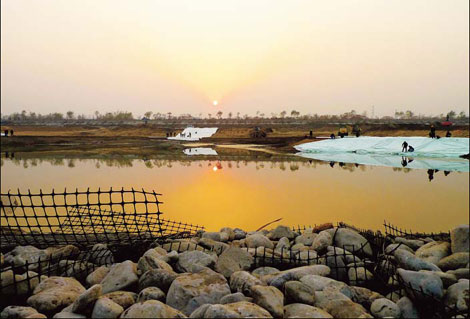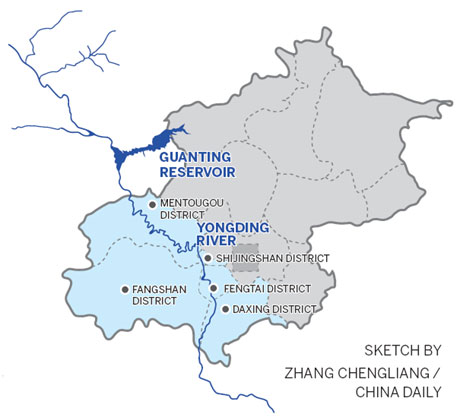|

Yongding River is having extensive work done in a widely-debated restoration project. Photo provided to China Daily |
|

The river passes right through Beijing. Photo provided to China Daily |
The city's Yongding River restoration project has benefits both economically and ecologically, including promoting a balanced development in Beijing and recharging the dwindling groundwater, officials say.
About three-quarters of the first-stage construction in 2010 had been finished by Dec 6, when the circulation pipes connecting four lakes along the river had been paved and tested.
"A low underground water table, sandstorms generated from the dry river course and garbage piled up in the river bed - none of these will be related to Yongding River once the project is finished," said Zhang Shiqing, vice-inspector of the Beijing Water Authority, which is in charge of the project.
Yongding River flows through five districts in the west part of Beijing, which occupies 30 percent of the city's total area but with only 12 percent of the city's GDP.
"A balanced development is what we want to achieve and the river project will definitely have a positive effect on the local economy," Zhang said.
But this is what worries environmentalists.
They are concerned that this biggest and longest artificial river in China may exacerbate Beijing's water shortages rather than relieve them.
"If the project succeeds, the city will be put in the awkward situation of being even thirstier due to the added urban expansion," said Wang Jian, a water expert at the Beijing-based environmental protection organization Da'erwen.
"Massive economic development is planned in west Beijing following the restoration of the Yongding River, but water demand will grow with the size of the city, thus increasing the water shortage," Wang explained.
At the Beijing International Forum on the Revitalization of the Western Area on Oct 12, planners revealed more than a dozen economic development areas, comprising a total area of 5,650 hectares, in the west of the city along the Yongding River.
Wang warns that water-intensive development plans will worsen an already serious problem, but Zhang said development is not the issue.
"Beijing is extremely short of water, but we need to broaden the sources and use the water effectively, instead of constraining development."
This year on Sept 29, 200 million tons of water was transferred to Beijing from Hebei, according to the Beijing Water Authority.
China's South-to-North Water Diversion Project is intended to transfer water from the water-rich south, mainly the Yangtze River, to the drought-prone north. The first phase was due to be completed in 2010, but environmental concerns and resettlement issues pushed the expected completion date back to 2014.
The Yongding River, which spans 747 kilometers within five provinces, autonomous regions and municipal cities, is the mother river of Beijing and winds 170 km through the west of the city.
However, following the construction of 267 reservoirs in the upper reaches, the lower 78-km reaches has been almost dry and the ecosystems that depend on it have been seriously damaged since 1992, said Zhang Minqiu, an engineer with the Beijing Institute of Water.
In 2009, the municipal government launched an environmental project aimed at making Yongding River flow again, with a total investment of 16.9 billion yuan over five years.
The Ecological Corridor of the Yongding River will consist of six connected lakes, which will form an ecosystem of streams, lakes and marshlands. A circulation system will transfer water from downstream to the top, every day in a continuous cycle.
The first phase of the project beginning this year includes the circulation pipes and four lakes, said Deng Zhuozhi, chief designer of the project.
"Geomembranes are being paved on the river bed to slow the loss of water and pumps will be used to keep the water circulating, instead of flowing out of Beijing," Deng said.
However, some experts warn that the project will lead to other problems besides the potential added burden on water supplies.
Tang Kewang, a senior engineer at the water resource department of China Institute of Water Resources and Hydropower Research, said misconceptions in river restoration include building too many lakes on a river and placing artificial membranes on the riverbed.
"Large water surface areas accelerate evaporation and artificial membranes destroy the natural habitats of aquatic organisms," Tang said at the 2010 Yongding River Forum on Sept 27.
The river's yearly ecological water demand is 130 million cubic meters. Zhang, from the Beijing Water Authority, said there is no problem for the prepared water sources to meet this demand, which has already counted in evaporation rate.
"Reclaimed water from five sewage treatment plants in Beijing will be the main source, recycling through underground pipes," said Zhang.
"Water quality monitoring will be conducted at least once a month," he said. "The water will also be purified by the marshland before entering the river course."
As to the membrane technology, Zhang said it could keep the water in a lake for a longer time and gradually recharge underground water, reaching about 100 million cu m a year.
Another concern of the water experts about the project is flood control.
Deng wrote on his blog on July 24 that the project was designed so it can withstand a flood happening every three years, which seems safe enough as Beijing has not experienced a flood in 55 years.
But Wang from Da'erwen disagrees: "If the capital's continuous drought ends in the next decade or two and there is a flood, the project will be in vain."
In response, Zhang said the project is well-prepared for a flood.
"In some dangerous section of the river course, the left dike - the side that is closer to the city center - has been designed to resist a flow rate at 16,000 cu m every second," he said.
In contrast, the historical max flow rate of Yongding River is 10,004 cu m a second, recorded in 1801.
But it is not just the Beijing section of the proposed river restoration project that people have concerns about.
"The problem with the Yongding River lies in its whole drainage area," said Wu Wentao, deputy director of the history department at Beijing Academy of Social Sciences.
"We need to start from the conservation of water resources if we want to bring a fundamental change to the river," she said.
Following a journey in June 2010 with staff members of Da'erwen to the upper reaches of the Yongding River in Shanxi province, the Inner Mongolia autonomous region and Hebei province, Wang, as well as many other water experts, called for a transregional comprehensive restoration of the river.
According to Zhang from the Beijing Water Authority, this is already in progress.
He said investment from the central government has been increasing year-on-year since the 1980s and a comprehensive restoration plan has already under way.
China Daily
(China Daily 12/22/2010)
|